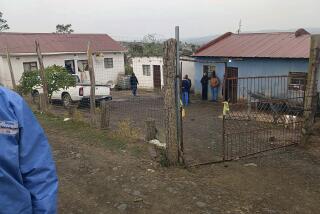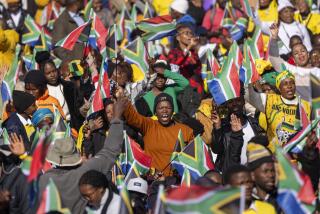Hanging Sparks Black Rampage in Johannesburg
- Share via
JOHANNESBURG, South Africa — Hundreds of angry black youths rampaged through central Johannesburg for three hours Friday afternoon to protest the government’s execution of a black poet, a member of the outlawed African National Congress.
Despite scores of appeals from world leaders as well as South Africans for clemency, Benjamin Moloisi, 31, was hanged early Friday morning in the domed-roof execution hall of Pretoria’s Central Prison. He had been convicted of murder in the killing three years ago of a black security policeman.
He admitted belonging to the African National Congress, helping to plan the policeman’s “execution” and being present when the officer was shot. But he argued in his appeal that he had been coerced and threatened with death if he did not help the agents sent to kill the policeman.
Smashing and Looting
In the ensuing riot, more than 1,500 blacks, angered by the execution, smashed store windows, looted about 10 shops, assaulted dozens of white passers-by and motorists and started to march on downtown offices before police, reinforced by heavily armed combat troops, contained the riot and eventually restored order.
The riot was the first in downtown Johannesburg in more than a year of sustained civil unrest in South Africa. Its strong black-versus-white character reflected increasing black militancy and the readiness of many black youths to use violence in the struggle against apartheid, South Africa’s system of racial segregation and white minority rule.
A policeman was stabbed in the back and seriously injured in one melee, and several others were injured as groups of black youths, apparently no longer afraid of police dogs, whips and guns, pounced on constables who had chased them. The youths beat and kicked the officers until they broke free and escaped. Although several shots were heard, police were clearly reluctant to use any weapons, even tear-gas grenades, in the crowded downtown.
The clashes, which began outside the offices of the South African Council of Churches, where a lunchtime memorial service was held for Moloisi, spread over a 12-block area and lasted into the evening rush hour. Thousands of black and white commuters, heading for the main railway station and suburban trains home, found themselves engulfed in the fighting and greeted at the station by a phalanx of railway police with submachine guns and tear-gas grenade launchers at the ready.
Some whites joined the clashes to help the police. Residents of nearby buildings bombarded the blacks with flower pots, bags of garbage and other debris from their balconies, and the blacks threw back stones, soft drink bottles and whatever else they could find.
A white motorist, caught by a mob at an intersection, reached under the front seat of his car and pulled out a sawed-off shotgun which he shoved in the faces of black youths trying to open the door of the car. They dispersed. And a white passer-by, seeing two elderly whites being assaulted by black youths, drew a pistol from under his jacket, fired a warning shot in the air and waded into the crowd to rescue the couple.
Violence in Cape Town
Further unrest was reported from Cape Town, where police said they shot and killed a 29-year-old Colored, or mixed-race, man during a gun battle around a mosque late Thursday in Athlone, a Colored suburb. Police said they fired back with military assault rifles after they came under a hail of bullets from a heavy-caliber weapon, and a police sergeant was shot in the stomach and seriously wounded.
Police said on Friday that shots had been fired at them on at least six different occasions in Cape Town’s Colored suburbs this week in what they regard as one of the most serious developments in the continuing unrest. The battle at the mosque was the first sustained exchange of gunfire in the 14 months of unrest. Police also said they are now being attacked with highly flammable phosphorus bombs, as well as Molotov cocktails made from gasoline-filled bottles with lighted newspaper wicks.
In an effort to restore calm to Athlone, hundreds of additional policemen and soldiers were moved into the middle-class suburb, with a soldier stationed every five yards along most streets and a platoon at each intersection. All cars and pedestrians were searched. Soldiers also established a cordon around the whole suburb, which has been the focus of much of the unrest in the Cape Town area for the past three months.
Police Warn Shooters
“Those who shoot at security forces must realize that they must bear the consequences,” Cape Town’s new hard-line police commissioner, Brig. C.A. (Blackie) Swart, said, warning of even tougher measures to come. “They must realize that they are playing with fire and that they must not cry if we take strong action.”
Funerals for 10 victims of the unrest are scheduled for today in Cape Town’s black and Colored townships, and community leaders have appealed to police to stay away from the services where tension is always high.
According to figures from President Pieter W. Botha’s office Friday, 761 persons, most of them black, have been killed nationwide in the unrest since September, 1984. Of those, 514 have been killed by the police, army or local officials, and 232 blacks suspected of being government collaborators have been killed by other blacks; 14 policemen, all black, and one white soldier have also been killed.
Anti-government feelings are also running high in Soweto, the black satellite city outside Johannesburg, where Moloisi, 31, an upholsterer by trade but at heart a poet and political activist, lived. Although it is under virtual martial law because of the partial state of emergency declared by President Botha three months ago, Soweto could erupt in further protests this weekend, according to black political observers, because of the deep anger over Moloisi’s execution.
Mother Denied Body
Moloisi’s mother, Pauline, had come to be near her son at his death but was not permitted into the prison until more than an hour after his execution. Then she was only allowed to see his closed black wooden coffin in the prison chapel. She asked for his body for burial, but was told that it remains “state property” under South African law and would be buried by the government. She should return next week, a prison official said, “to pick up a grave number.”
“This government is so cruel, cruel, cruel,” she said as she emerged from the prison with her husband, Robert, to sing with a small group of relatives, friends and supporters a moving Christian hymn, “God Bless Africa,” that has become the anthem of the anti-apartheid movement.
Among the mourners at the prison was Winnie Mandela, wife of Nelson Mandela, jailed leader of the African National Congress, who defied government restrictions on her travels to be present.
From Lusaka, Zambia, the African National Congress described Moloisi as a martyr in the liberation struggle and called upon other black South Africans to strengthen their resolve to fight apartheid.
‘Even Greater Blows’
“To our people, we say that the murder of Benjamin Moloisi must become the signal of even greater blows against the enemy in every corner of our land,” the group declared.
Winnie Mandela spoke at the memorial service along with Pauline Moloisi and the Rev. C.F. Beyers Naude, general secretary of the South African Council of Churches. “We need you all to join hands to fight the immoral Pretoria regime,” Winnie Mandela told the 500 at the serivce.
Her speech, the first such public appearance she has made since she was banned nearly a decade ago from political activities, electrified the audience. Spectators shouted “Viva Mandela!” and “amandla!” or “power,” then streamed out of the building declaring their allegiance to her husband, jailed for life on sabotage charges, and calling for his release.
“Mandela wethu--somlandela, somlandela (Mandela, we will follow our Mandela),” the youths chanted.
But those shouts turned quickly into the more militant “Siyanyova, siyanyova, “ or “We will destroy, we will destroy,” as more than 1,000 youths, some waiting outside but others just passing by, joined those leaving the service.
Store windows were quickly shattered, shops were stripped by looters, customers coming out of other stores were robbed of their purchases. Whites in the down-at-the-heels neighborhood were assaulted; some, including reporters from local newspapers, were badly beaten by the black youths, but others, mostly foreign newsmen, became targets for the police.
More to Read
Sign up for Essential California
The most important California stories and recommendations in your inbox every morning.
You may occasionally receive promotional content from the Los Angeles Times.












